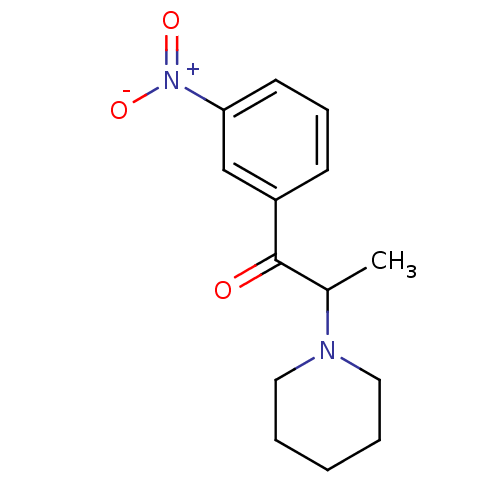BDBM50308120 2-(N-Pyrrolidinyl)-3'-nitropropiophenone::CHEMBL599233
SMILES CC(N1CCCCC1)C(=O)c1cccc(c1)[N+]([O-])=O
InChI Key InChIKey=LTLFRBMKBHQUTH-UHFFFAOYSA-N
Data 4 IC50
Activity Spreadsheet -- Enzyme Inhibition Constant Data from BindingDB
 Found 4 hits for monomerid = 50308120
Found 4 hits for monomerid = 50308120
TargetSodium-dependent serotonin transporter(Homo sapiens (Human))
Research Triangle Institute
Curated by ChEMBL
Research Triangle Institute
Curated by ChEMBL
Affinity DataIC50: >100nMAssay Description:Inhibition of [3H]serotonin uptake at human SERT expressed in HEK293 cellsMore data for this Ligand-Target Pair
TargetNeuronal acetylcholine receptor subunit alpha-4/beta-2(Homo sapiens (Human))
Research Triangle Institute
Curated by ChEMBL
Research Triangle Institute
Curated by ChEMBL
Affinity DataIC50: >100nMAssay Description:Antagonist activity at human alpha4beta2 nAChR receptor expressed in human SH-SY5Y cells assessed as inhibition of carbamylcholine-induced 86Rb+ effl...More data for this Ligand-Target Pair
TargetSodium-dependent dopamine transporter(Homo sapiens (Human))
Research Triangle Institute
Curated by ChEMBL
Research Triangle Institute
Curated by ChEMBL
Affinity DataIC50: 1.00E+4nMAssay Description:Inhibition of [3H]dopamine uptake at human DAT expressed in HEK293 cellsMore data for this Ligand-Target Pair
TargetSodium-dependent noradrenaline transporter(Homo sapiens (Human))
Research Triangle Institute
Curated by ChEMBL
Research Triangle Institute
Curated by ChEMBL
Affinity DataIC50: 4.10E+3nMAssay Description:Inhibition of [3H]norepinephrine uptake at human NET expressed in HEK293 cellsMore data for this Ligand-Target Pair
